I KNOW WHAT YOU DID LAST DRY SEASON!

“Fear of failure and fear of disappointment existed
but the poui never worried
times of blossom are planned but I saw it constant.”
~Anonymous
Legend has it that when the Poui (pronounced poo-ee) trees are in bloom, examinations generally follow closely after. Is this tree flowering to alert students when the dreaded exams are near? Or does this represent something more?

During the dry season which runs from January to May, the floor of the Queen’s Park Savannah’s is littered with pink and yellow trumpet-shaped flowers. These vibrant colours have painted the canopies near our highways for decades. In Trinidad, when the Poui blooms, the majority of green vegetation upon the Northern Range becomes replaced with splashes of yellow. Do all these yellow flowers on the Northern Range belong to Poui trees?

In a one-on-one exclusive with senior lecturer at UWI, St. Augustine, Dr. Oatham, who has an extensive knowledge on forest trees and plants in the Caribbean, he helped answered these questions. Dr. Oatham who has worked on Protected areas in Trinidad and Tobago such as the Aripo savannas, was one of our lecturers during our undergrad years. He is now one of Aaron’s closest friends.
There are about five (5) species of Poui in Trinidad and Tobago. Due to recent changes in the classification of Poui species’ names, these five species fall into two main groups: Tabebuia and Handroanthus. In T&T there exists two kinds of yellow Poui trees: yellow and black. Both the yellow and black Poui species have yellow flowers, and belong to the Handroanthus (H.) group, while the pink and white Poui fall under the Tabebuia (T.) group.
The yellow Poui, formerly known by its scientific name, T. serratifolia is now called H. serratifolia. According to the book Flowers of the Caribbean by G.W. Lennon & S.A. Seddon, it grows to a height of 70 or 80 feet and is considered to be one of the “largest tropical forest specimens.” Similarly, the black Poui previously called T. chrysantha is now known as H. chrysanthus.

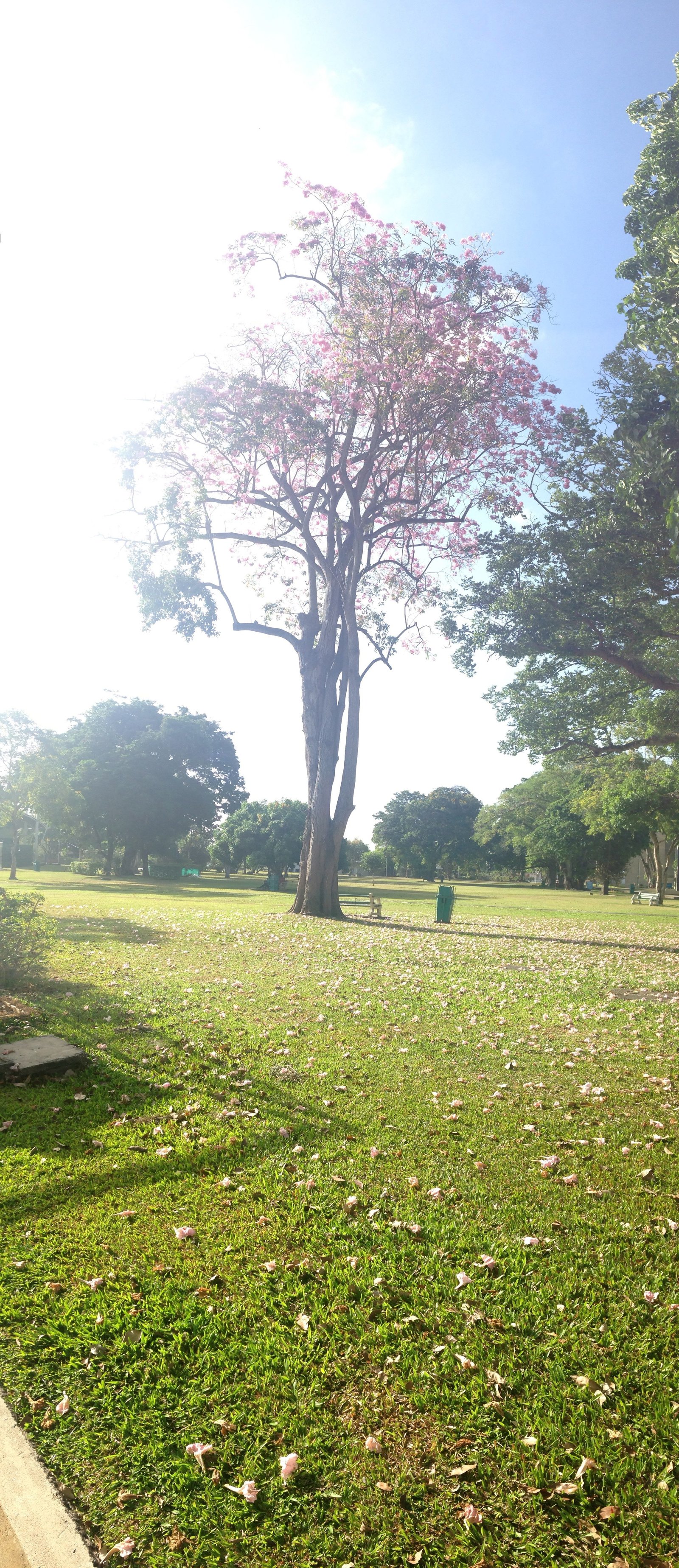
The light pink Poui called T. pallida in the past is renamed T. heterophylla. It is found more commonly up the islands in Trinidad around the drier parts, and also occurs in Tobago. There is also the rosy pink Poui (T. rosea), which is the national tree of Venezuela and was introduced to Trinidad. The pink Poui can attain a height of 60 or 70 feet.
(Like this big fella with a pink crown to the left)
The fifth species is the white Poui called T. stenocalyx. It is also called “wild calabash” because its leaves have a similar shape to calabash leaves, and also “white cedar” although it looks nothing like cedar. It has white flowers and it is fairly common in Trinidad.
So do all those yellow flowers seen along the hills of the Northern Range belong to Poui trees?
The short answer is No.
So who are these imposters?
Tecoma stans, also called “Christmas hope” or “Christmas bush” has similar yellow flowers like the yellow Poui but the leaves are different. This species looks more like a bush and less like a tree. It is used extensively in cultivation and probably “escaped” cultivation and became “naturalized” as the seeds are wind dispersed and could have spread extensively. Tecoma stans can also be found “down the islands” like in Monos and Chacachacare, as well as in Tobago.
Cassia fistula, also known by its common name, “Golden Shower Tree” is a legume which originates from India. It is cultivated, not “naturalized” and can grow to a height of 30 or 40 feet.
They all flower generally during the dry season, around the same time as the yellow Poui, so it’s easy for them to get away with the deception!

What are some of the ecosystem services Poui trees provide?
Poui trees offer many eco-system services from: soil protection and erosion prevention; preserving hydrology and watershed protection, predominantly in the Northern Range; preventing siltation and flooding through water diversion and modifying stream flow; aesthetics; providing a food source (nectar) to insects, bees, hummingbirds and bats; and lumber.
Poui wood is a High quality wood and it is important commercially in South America. The wood of the yellow Poui is exceptionally tough, strong, hard, and resistant to both termite and general decay. It is one of the most durable woods in Trinidad. Therefore, it is often used in building and construction work, especially for outdoor decks and boardwalks.
I wonder if the Chaguaramas boardwalk is made from yellow Poui wood?
This wood is preferred over cedar because it is three (3) times stronger and also because most of the cedar has been cut down and is becoming vulnerable.
The wood of the pink Poui is often used in internal building work, (and perhaps even coffins!)
Did you know?
The long, strong stick (also called bois) used in Kalinda or stick-fighting, an old tradition brought to Trinidad by the slaves is made from a piece of cured Poui.
Do the Poui trees really warn students about upcoming CSEC, CAPE and final semester exams?
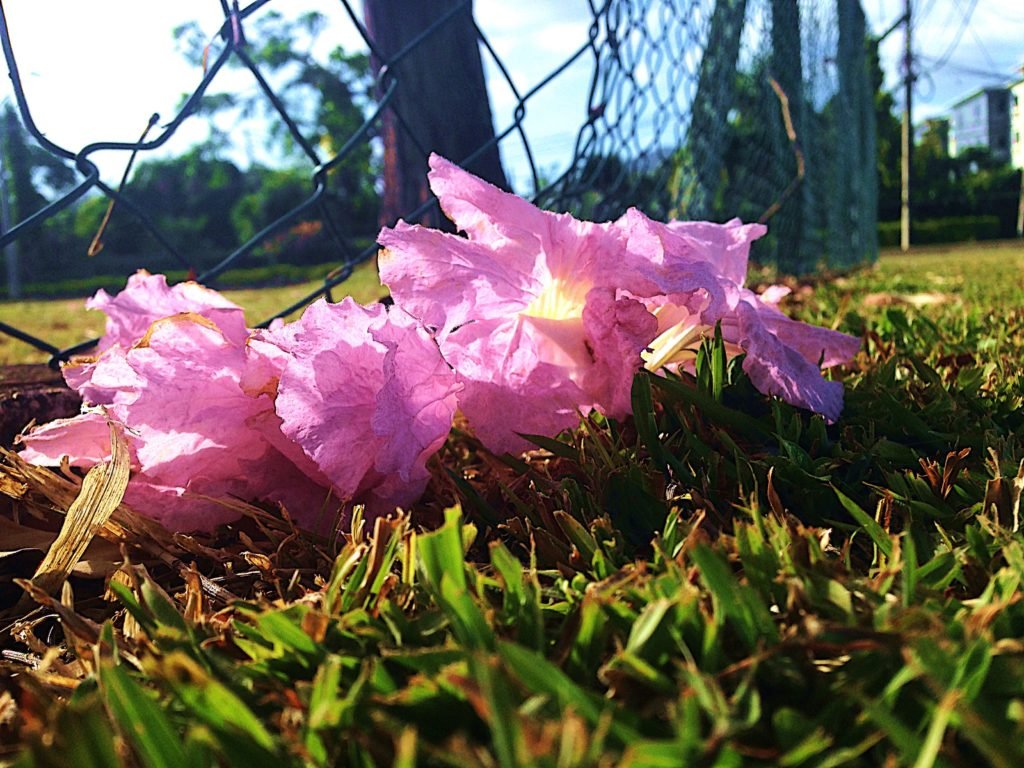
Well…, yes and no.
Yes, in the sense that you better start your exam prep (or cramming!) once those first signs of blooms come peeping out at you.
And no, because let’s face it; it’s a bit ridiculous to think that the Poui trees are your very own personal calendar reminder! This is not one of their ecosystem services.
So what are the Poui trees really saying then?
In the yellow Poui for example, when the dry season occurs, they drop their leaves. This is done to preserve energy. Trees have to work on a budget where the currency is carbon. They have an income: carbon dioxide & water (photosynthesis), and they have an expenditure (respiration).
During the dry season, there is less water available for photosynthesis, which converts the carbon and water into carbohydrates. These carbohydrates provide energy for the plant to build structures to maintain cells, and to facilitate the biochemical reactions within them. However, during the process of building these structures, respiration is also required.
Each tree has a budget -photosynthesis (income) coming in and respiration (expenditure) going out. Photosynthesis is dependent on the availability of light and water. Without water, photosynthesis cannot occur. Therefore, the availability of energy becomes scarce as a result. Water brings in the carbon and converts them to carbohydrates, and it is integral to ensure that the stomata (tiny openings used for gas exchange) in the leaves opens up.
When the stomata open, water comes out and you lose water. During the dry season, water is in short supply so the plant closes the stomata to reduce water loss. But if the stomata are not open, then carbon dioxide cannot enter the plant and therefore no photosynthesis can occur.
Respiration still needs to occur and since the rate of energy production is less than the rate of energy used, the Poui will do what any good company would do by “cutting costs.” It does this by dropping the leaves since it requires energy to maintain their integrity.

With a brief rain shower, the amount of water uptake in the tree swells the trunk a bit and uses this as a cue to synchronize flowering. So water goes into the trunk and reaches a certain pressure which triggers the process of flowering in the Poui trees. That’s why not long after a rain shower, many of the trees in the Northern Range start to flower around the same time.
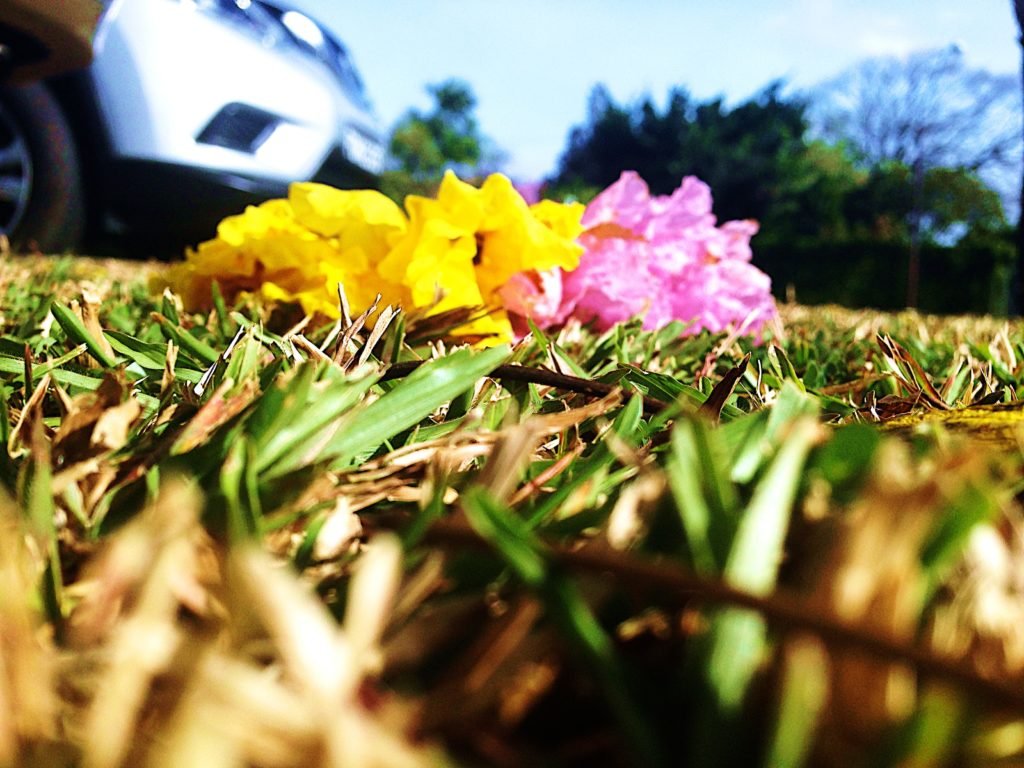
Flowering is sexual reproduction in plants. It needs to be synchronized because cross pollination can only occur if the Poui trees flower at the same time. This maximizes pollen transfer and gene shuffling in order to preserve genetic diversity.
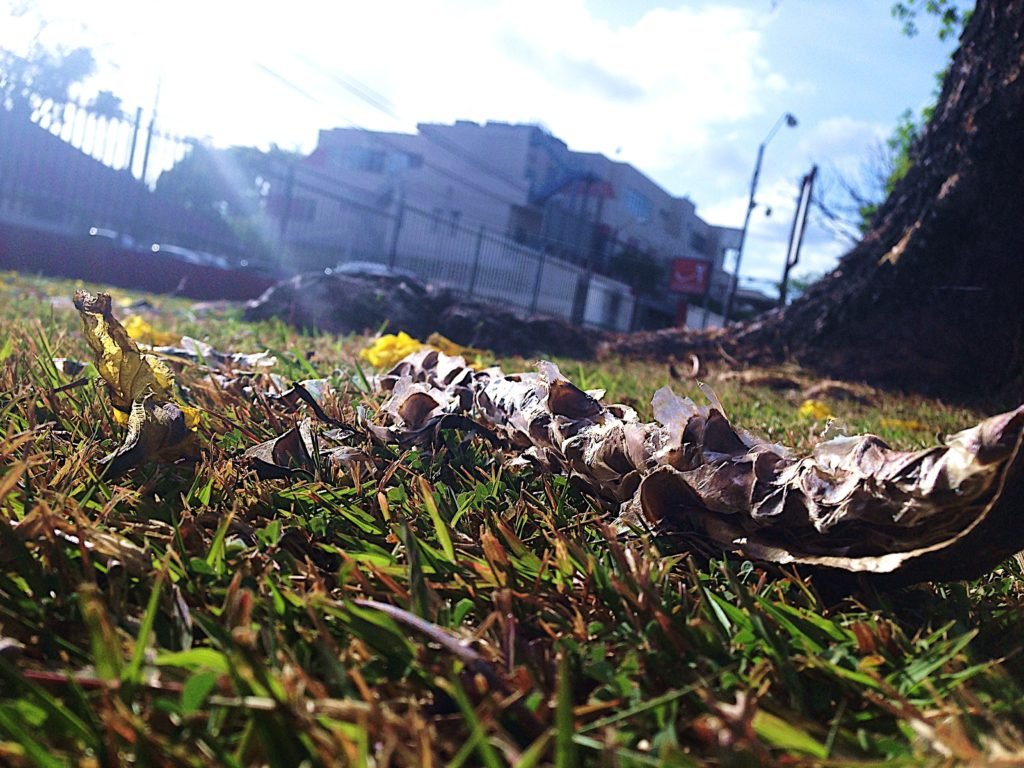
The seeds which are wind dispersed from a long pod can travel many kilometres. They can reach Venezuela but not Tobago because of the direction of the prevailing Trade winds.
So once again I know what you did last dry season,…you bloomed!
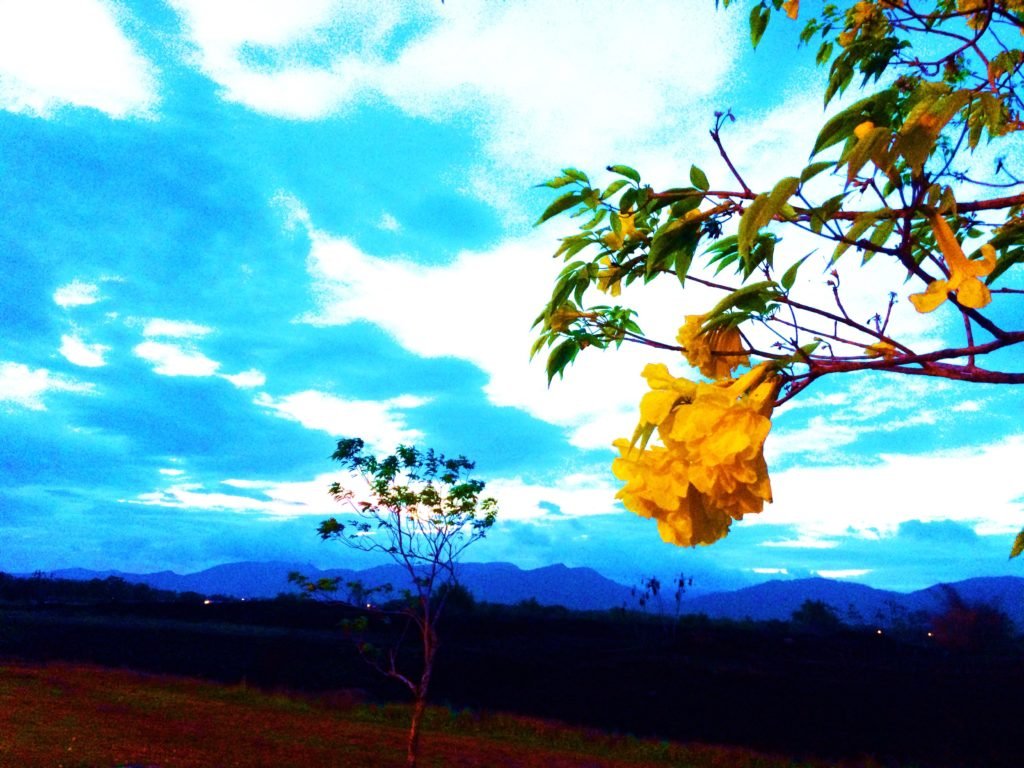 A yellow Poui (T. serratifolia) dots the evening sky around the Piarco International Airport Terminal
A yellow Poui (T. serratifolia) dots the evening sky around the Piarco International Airport Terminal
Photographer & Editor: A. Peter
“And no, because let’s face it; it’s a bit ridiculous to think that the Poui trees are your very own personal calendar reminder! This is not one of their ecosystem services.” Loll that last line. ?
This was so well-researched, so much attention to detail, so much effort and care put into this, including the images along the way.
Excellent information on our native flora and great Journalism skills. Keep up the great work